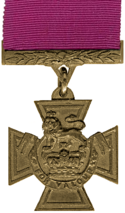- Charles FitzClarence
-
Charles FitzClarence 
Born 8 May 1865
Bishopscourt, County KildareDied 2 November 1914 (aged 49)
Polygon Wood, Zonnebeke, BelgiumBuried at Menin Gate Memorial Allegiance  United Kingdom
United KingdomService/branch  British Army
British ArmyYears of service 1886 - 1914 Rank Brigadier General Unit Royal Fusiliers
Irish GuardsCommands held 1st Guards Brigade Battles/wars Mahdist War
Second Boer War
World War I †Awards Victoria Cross Brigadier General Charles FitzClarence VC (8 May 1865 — 2 November 1914) was an Irish recipient of the Victoria Cross, the highest and most prestigious award for gallantry in the face of the enemy that can be awarded to British and Commonwealth forces.
Charles FitzClarence was born in County Kildare, the son of Captain George FitzClarence (15 April 1836 - 24 March 1894) and Maria Henrietta Scott (d. 27 July 1912). He had a twin brother named Edward. His paternal grandfather was George Augustus Frederick FitzClarence, 1st Earl of Munster, an illegitimate son of William, Duke of Clarence (later King William IV of the United Kingdom). He served in the Sudan during the Mahdist War.
FitzClarence was 34 years old, and a captain in The Royal Fusiliers, British Army during the Second Boer War when the following deeds took place for which he was awarded the Victoria Cross:
On the 14th October, 1899, Captain FitzClarence went with his squadron of the Protectorate Regiment, consisting of only partially trained men, who had never been in action, to the assistance of an armoured train which had gone out from Mafeking. The enemy were in greatly superior numbers, and the squadron was for a time surrounded, and it looked as if nothing could save them from being shot down. Captain FitzClarence, however, by his personal coolness and courage inspired the greatest confidence in his men, and, by his bold and efficient handling of them, not only succeeded in relieving the armoured train, but inflicted a heavy defeat on the Boers, who lost 50 killed and a large number wounded, his own losses being 2 killed and 15 wounded. The moral effect of this blow had a very important bearing on subsequent encounters with the Boers.On the 27th October, 1899, Captain FitzClarence led his squadron from Mafeking across the open, and made a night attack with the bayonet on one of the enemy's trenches. A hand-to-hand fight took place in the trench, while a heavy fire was concentrated on it from the rear. The enemy was driven out with heavy loss. Captain FitzClarence was the first man into the position and accounted for four of the enemy with his sword. The British lost 6 killed and 9 wounded. Captain FitzClarence was himself slightly wounded. With reference to these two actions, Major-General Baden-Powell states that had this Officer not shown an extraordinary spirit and fearlessness the attacks would have been failures, and we should have suffered heavy loss both in men and prestige.
On the 26th December, 1899, during the action at Game Tree, near Mafeking, Captain FitzClarence again distinguished himself by his coolness and courage, and was again wounded (severely through both legs).[1]He was transferred to the Irish Guards on that regiment's formation in October 1900. He became a Major in May 1904 and succeeded to the command of the 1st Battalion Irish Guards in July 1909. He later achieved the rank of Brigadier General. He was killed in action, aged 49, at Polygon Wood, Zonnebeke, Belgium, on 12 November 1914 whilst commanding the 1st Guards Brigade.[2]
He is the highest ranking officer inscribed on the Menin Gate Memorial in Ypres, commemorating those with no known grave. His VC is in the Lord Ashcroft VC Gallery in the Imperial War Museum, London.
Family
He married Violet Spencer-Churchill (13 June 1864 - 22 December 1941), daughter of Lord Alfred Spencer-Churchill and a granddaughter of the sixth Duke of Marlborough, on 20 April 1898. The couple had two children:
- Edward Charles Fitzclarence, 6th Earl of Munster (b. 3 October 1899 - d. 1983)
- Joan Harriet Fitzclarence (b. 23 December 1901)
References
- ^ London Gazette: no. 27208. p. 4196. 6 July 1900. Retrieved 14 November 2009.
- ^ Casualty Details—Charles FitzClarence, Commonwealth War Graves Commission. Retrieved on 15 November 2009.
Listed in order of publication year
- The Register of the Victoria Cross (1981, 1988 and 1997)
- Clarke, Brian D. H. (1986). "A register of awards to Irish-born officers and men". The Irish Sword XVI (64): 185–287.
- Irelands VCs (Dept of Economic Development 1995)
- Monuments to Courage (David Harvey, 1999)
- Irish Winners of the Victoria Cross (Richard Doherty & David Truesdale, 2000)
- "Elegant Extracts" - The Royal Fusiliers Recipients of the VC (J.P. Kelleher, 2001)
- Royal Fusiliers Recipients of the Victoria Cross
External links
Categories:- 1865 births
- 1914 deaths
- People from County Kildare
- FitzClarence family
- Second Boer War recipients of the Victoria Cross
- British recipients of the Victoria Cross
- Irish recipients of the Victoria Cross
- British Army World War I generals
- Royal Fusiliers officers
- Irish Guards officers
- British military personnel killed in World War I
- British Army personnel of the Second Boer War
- Old Etonians
- Old Wellingtonians
- British Army personnel of the Mahdist War
Wikimedia Foundation. 2010.
